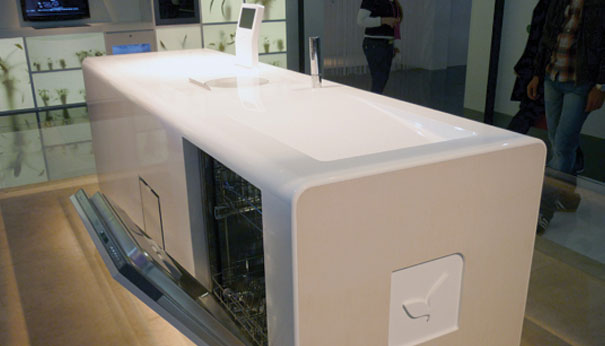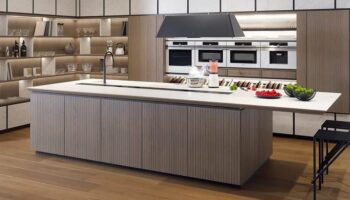It’s Not Easy Being Green: Whirlpool’s Eco-System Kitchen
Who Knew green could be so white? Whirlpool, that’s who. Their gleaming white Eco-System Kitchen does the company’s storied 100-year lineage proud. At least in my personal memory banks, the Whirlpool name is synonymous with a certain childhood nostalgia–I still remember the sonorous whoosh of the wash cycle of my mom’s first Whirlpool washer, an appliance that was, incidentally, gleaming white. Times have changed a bit since the days of that over-sized piece.
Eco-System Kitchen. Designed by Whirlpool.
My Mom has long-since replaced the original for an equally reliable–and measurably quieter– specimen from Whirlpool’s Energy Star Series, and the company has grown by leaps and bounds. Since merging with Maytag in 2006, the appliance manufacturer has become one of the world’s largest makers of home appliances (in case you’re taking notes, that’s clothes washers, dishwashers, ovens, refrigerators, cooktops, garbage disposers, ice-makers, microwaves, water heaters, and HVAC systems).
One look at Eco-System and you might conjecture if each of the above has found a home in its slim confines. The answer to the hypothetical query would be “not quite, but almost.” The new concept–which Whirlpool debuted at this year’s Salone with the attractive prototype shown–incorporates a dishwasher, refrigerator, stove, and oven. That degree of proximity and containment–an all-in-one package that’s sustainable for its time and transportation savings alone–might be enough to earn the green moniker in and of itself, but, as the Sham-Wow! guy once said, “wait, there’s more…” Eco-System’s smart induction oven not only re-captures heat, but also calculates water quantities required for a given cooking task. The result is an average 20% savings on energy costs and 25% savings on time. If you like those numbers, you’ll like these even more: Eco-System recycles all cooking and sink water via an extensive filtration process, then stores the same for later use in the dishwasher. Other features include solar panels for heating water and a computerized “resource assistant” cleverly hidden in the countertop. This technological innovation monitors consumption and costs, in addition to providing “other information useful for cooking.”
Via Inhabitat







Leave a Reply